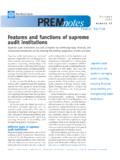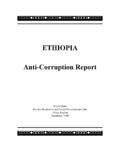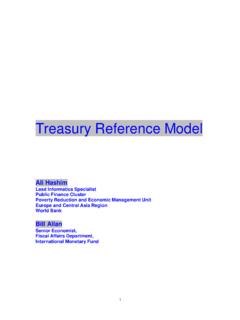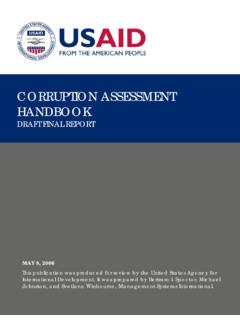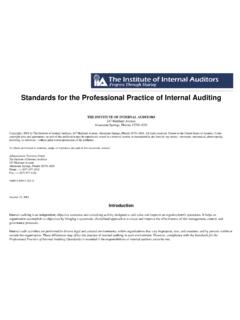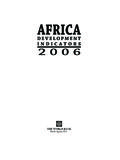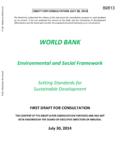Transcription of What is Stakeholder Analysis - World Bank Group
1 What is Stakeholder Analysis ? Stakeholder Analysis (SA) is a methodology used to facilitate institutional and policy reform processes by accounting for and often incorporating the needs of those who have a stake or an interest in the reforms under consideration. With information on stakeholders, their interests, and their capacity to oppose reform, reform advocates can choose how to best accommodate them, thus assuring policies adopted are politically realistic and sustainable. Although Stakeholder Analysis originated from the business sciences, it has evolved into a field that now incorporates economics, political science, game and decision theory, and environmental sciences. Current models of SA apply a variety of tools on both qualitative and quantitative data to understand stakeholders, their positions, influence with other groups, and their interest in a particular reform.
2 In addition, it provides an idea of the impact of reform on political and social forces, illuminates the divergent viewpoints towards proposed reforms and the potential power struggles among groups and individuals, and helps identify potential strategies for negotiating with opposing stakeholders. Who Are Stakeholders? A Stakeholder is any entity with a declared or conceivable interest or stake in a policy concern. The range of stakeholders relevant to consider for Analysis varies according to the complexity of the reform area targeted and the type of reform proposed and, where the stakeholders are not organized, the incentive to include them. Stakeholders can be of any form, size and capacity. They can be individuals, organizations, or unorganized groups.
3 In most cases, stakeholders fall into one or more of the following categories: international actors ( donors), national or political actors ( legislators, governors), public sector agencies ( MDAs), interest groups ( unions, medical associations), commercial/private for-profit, nonprofit organizations (NGOs, foundations), civil society members, and users/consumers. Major Attributes to Consider Four major attributes are important for Stakeholder Analysis : the stakeholders position on the reform issue, the level of influence (power) they hold, the level of interest they have in the specific reform, and the Group /coalition to which they belong or can reasonably be associated with. These attributes are identified through various data collection methods, including interviews with country experts knowledgeable about stakeholders or with the actual stakeholders directly.
4 The level of influence depends on the quantity and type of resources and power the Stakeholder can marshal to promote its position on the reform. The level of interest or salience is the priority and importance the Stakeholder attaches to the reform area. Broadly, these attributes signal the capability the Stakeholder has to block or promote reform, join with others to form a coalition of support or opposition, and lead the direction/discussion of the reform. SA therefore provides a detailed understanding of the political, economic, and social impact of reform on interested groups, the hierarchy of authority and power among different groups and the actual perceptions of the reform among different groups, all of which are important for reform advocates to consider.
5 When to Conduct Stakeholder Analysis Timing is an important factor in the implementation of Stakeholder Analysis to assure the usefulness of the results for policy formulation. In most cases, SA should precede the finalizing of reform proposals. In early stages of policy formulation, SA can help gauge the likelihood of acceptance and sustainability of anticipated policy reforms. By initiating SA prior to the introduction of the reform and continuing to modify the policy proposal during the design process, potential obstacles to implementation and results can be avoided. When used at the right time and in conjunction with other tools such as qualitative political economy analyses and social impact assessments, Stakeholder Analysis can inform task team strategies to overcome opposition, build coalitions, and channel information and resources to promote and sustain proposed reform.
6 Data Collection Several methods can be employed to collect data on stakeholders in a comprehensive and efficient manner. Prior to the actual collection, a brief review of background literature and country studies can provide a useful understanding of the country s political economy. One method of collecting data is to conduct interviews directly with the stakeholders involved in the specific policy area. The second method is to interview local experts in the field who are knowledgeable about the issue and the important groups and individuals involved in the policy area. Some country team members ( country managers) often hold extensive local knowledge and can provide a critical first hand understanding of which stakeholders are relevant to the reform area.
7 However, unless resources and time do not permit, interviewing of local and international experts in the policy area or country and/or the stakeholders themselves is imperative. Broad, all-inclusive interviews will lead to an effective Stakeholder Analysis process since it will uncover many facets of the country s political economy. The content and questions of the interviews should focus on background information on the policy making process, information that identifies key stakeholders from a variety of groups in the reform process, and clarifying assumptions about stakeholders power and interest in the decision-making process. The number of interviews is determined by the research team, taking into consideration field conditions and logistical constraints ( sensitivity, access, time, budget, etc.)
8 Analyzing Data and Designing Strategy Data from interviews including scaled values assigned to the attributes and relative rankings calculated accordingly are catalogued and presented in charts and/or matrices, highlighting the following attributes: Group their interest (or salience) influence (power) position on the reform An important measure called effective power (degree of power the Stakeholder holds over other groups in relation to a reform area) is determined by weighting a combination of a Stakeholder s salience and influence. A clear assessment of each Stakeholder s power and likely impact on the policy making process is conducted through several steps. The first step is to create a continuum.
9 Stakeholders are mapped on a continuum indicating support for the reform on a scale of 0 to 100 from low (far left) to high (far right). The varying degrees of support are marked on the line with a value indicating their reform preference. This implement also provides a quick visual of the lay of the land , illuminating clusters of groups that support, oppose or are indifferent to reform. The next step is to organize the Stakeholder data according to relative power/influence and salience of each Stakeholder to understand their potential support or opposition for the proposed reform. Often, a matrix is used to organize and classify the Stakeholder data. One form is to map salience/interest and influence on the axes.
10 This matrix provides a shorthand categorization and Analysis of which stakeholders will gain or lose from a proposed reform and whether they can significantly impact the process. To guide strategic responses, stakeholders are categorized by their power and salience in a grid according to the following attributes: Promoters: Stakeholders who attach a high priority to the reform policy a priority and whose actions can have an impact on the implementation of the policy Defenders: Stakeholders who attach a high priority to the reform policy but whose actions cannot have an impact on the implementation of the policy Latents: Stakeholders whose actions can affect the implementation of the reform policy but who attach a low priority to this policy Apathetics.
